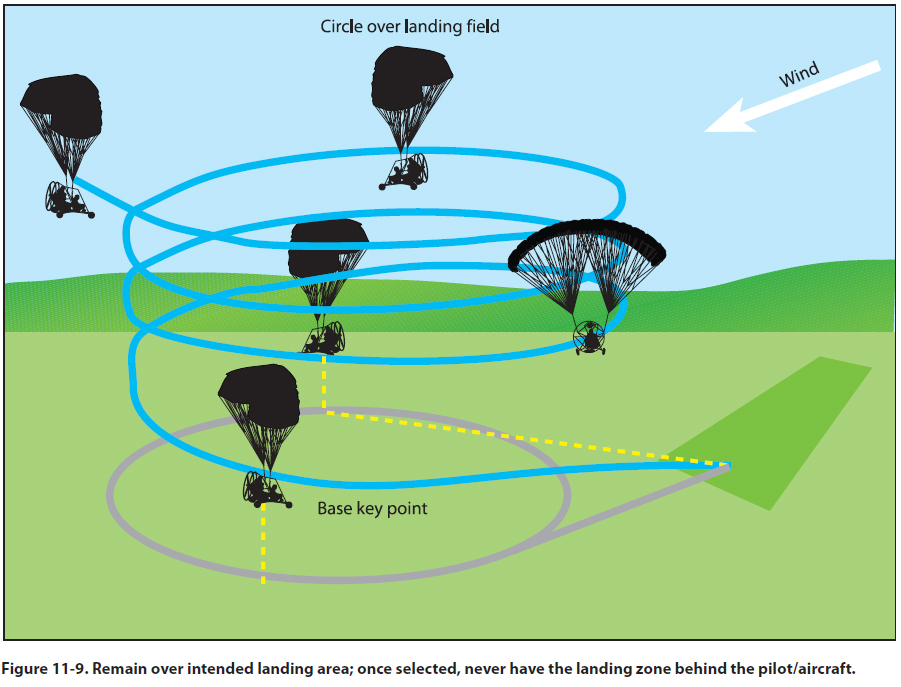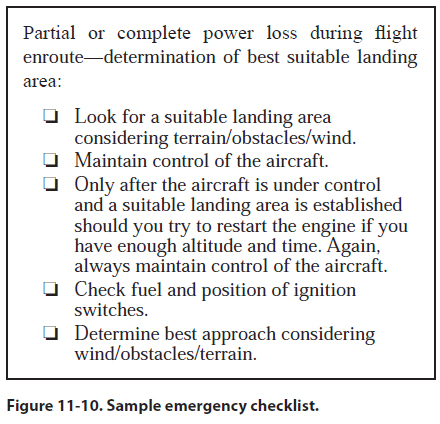|
Chapter 11 — Approaches and Landings
Turbulent Air Approach and Landing
Powered parachute flying is a low-wind sport. It is important
PPC pilots evaluate the upper-air winds to ensure
the wind is within the limitations for that aircraft,
accounting for wind shear and wind gust possibilities
at pattern altitude.
For flying in more turbulent air on final approach,
maintain power throughout the approach to reduce
your descent rate in case you do experience a down
gust. This will alleviate the possibility of an excessive
descent rate.
Emergency Approaches and
Landings (Simulated)
From time to time on dual flights, the instructor should
give simulated emergency landings by retarding the
throttle and calling “simulated emergency landing.”
The objective of these simulated emergency landings
is to develop the pilot’s accuracy, judgment, planning,
procedures, and confidence when little or no power is
available.
A simulated emergency landing may be given at any
time. When the instructor calls “simulated emergency
landing,” the pilot should consider the many variables,
such as altitude, obstruction, wind direction, landing
direction, landing surface and gradient, and landing
distance requirements. Risk management must be exercised
to determine the best outcome for the given
set of circumstances. The higher the altitude, the more
time the pilot has to make the decision of where to
land.
Using any combination of normal gliding maneuvers,
from wing level to turns, the pilot should eventually
arrive at the normal key position at a normal traffic
pattern altitude for the selected landing area. From
this point on, the approach will be as nearly as possible
a normal power-off approach. [Figure 11-9]

All pilots should learn to determine the wind direction
and estimate its speed. This can be done by observing
the windsock at the airport, smoke from factories or
houses, dust, brush fires, and windmills.
Once a field has been selected, the student pilot should
always be required to indicate it to the instructor. Normally,
the student should be required to plan and fly
a pattern for landing on the field elected until the instructor
terminates the simulated emergency landing.
This will give the instructor an opportunity to explain
and correct any errors; it will also give the student an
opportunity to see the results of the errors.
However, if the student realizes during the approach
that a poor field has been selected—one that would
obviously result in disaster if a landing were to be
made—and there is a more advantageous field within
gliding distance, a change to the better field should
be permitted. The hazards involved in these last-minute
decisions, such as excessive maneuvering at very
low altitudes, should be thoroughly explained by the
instructor.
During all simulated emergency landings, the engine
should be kept warm and cleared. During a simulated
emergency landing, either the instructor or the student
should have complete control of the throttle. There
should be no doubt as to who has control since many
near accidents have occurred from such misunderstandings.
Every simulated emergency landing approach should
be terminated as soon as it can be determined whether
a safe landing could have been made. In no circumstances
should you violate the altitude restrictions
detailed in 14 CFR part 91 or any local nonaviation
regulations in force. It is also important to be courteous
to anyone on the ground. In no case should it be
continued to a point where it creates a hazard or an
annoyance to persons or property on the ground.
In addition to flying the powered parachute from the
point of simulated engine failure to where a reasonable
safe landing could be made, the pilot should also
learn certain emergency cockpit procedures. The habit
of performing these cockpit procedures should be developed
to such an extent that, when an engine failure
actually occurs, the pilot will check the critical items that would be necessary to get the engine operating
again after selecting a field and planning an approach.
Accomplishing emergency procedures and executing
the approach may be difficult for the pilot during the
early training in emergency landings.
There are definite steps and procedures to follow in a
simulated emergency landing. They should be learned
thoroughly by the student, and each step called out
to the instructor. The use of a checklist is strongly
recommended. Most powered parachute manufacturers
provide a checklist of the appropriate items.
[Figure 11-10]

Critical items to be checked should include the quantity
of fuel in the tank and the position of the ignition
switches. Many actual emergency landings could have
been prevented if the pilots had developed the habit of
checking these critical items during flight training to
the extent that it carried over into later flying.
Instruction in emergency procedures should not be
limited to simulated emergency landings caused by
power failures. Other emergencies associated with
the operation of the powered parachute should be ex-plained, demonstrated, and practiced if practicable.
Among these emergencies are such occurrences as fire
in flight, electrical system malfunctions, unexpected
severe weather conditions, engine overheating, imminent
fuel exhaustion, and the emergency operation of
powered parachute systems and equipment.
|

